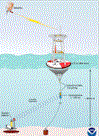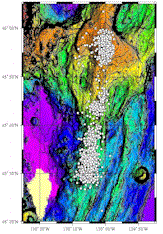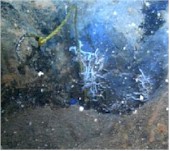 NOAA /
OAR / ERL /
PMEL
NOAA /
OAR / ERL /
PMEL
 NOAA /
OAR / ERL /
PMEL
NOAA /
OAR / ERL /
PMEL
Strategic Plan Element: Rebuild Sustainable Fisheries
Objective: Advance Fisheries Predictions
Performance Measure: Improve technology for modeling and predicting survival of larvae and juveniles, and recruitment.
 ecosystem observations
this year, moorings were
deployed at standard
FOCI sites in the
southeastern Bering Sea
during February. It was
noted that Bering Sea ice
had retreated north of
mooring 2 (see figure at
left) by March.
Measurements at this
mooring showed a cold,
fresh water surface layer
and warmer, more saline
water at the bottom. In
spring, four cruises
investigated shelf and
slope waters during the
period April 14 to June
19. The purpose of these cruises was to examine the spring
phytoplankton bloom and its associated physical, chemical, and
biological oceanographic processes. During the cruises, moorings
were recovered and/or deployed at sites 2, 3, 4, and 6. Scientists
conducted biological and physical sampling using net tows and CTD
casts at and between mooring sites.
ecosystem observations
this year, moorings were
deployed at standard
FOCI sites in the
southeastern Bering Sea
during February. It was
noted that Bering Sea ice
had retreated north of
mooring 2 (see figure at
left) by March.
Measurements at this
mooring showed a cold,
fresh water surface layer
and warmer, more saline
water at the bottom. In
spring, four cruises
investigated shelf and
slope waters during the
period April 14 to June
19. The purpose of these cruises was to examine the spring
phytoplankton bloom and its associated physical, chemical, and
biological oceanographic processes. During the cruises, moorings
were recovered and/or deployed at sites 2, 3, 4, and 6. Scientists
conducted biological and physical sampling using net tows and CTD
casts at and between mooring sites.
Spring conditions were well documented. Temperatures in the
southeastern Bering Sea were warmer than previous years, and
there was more storm activity. The level of thermal stratification
was less pronounced (the shelf was well mixed to 80m through
May) as a result. A recognizable spring phytoplankton bloom had
not started by June, and by the end of the season, no spring bloom
was evident in either the middle or outer shelf domains. Anomalous
conditions (see workshop page) prevailed again this summer with a second year's
coccolithophore bloom over the Bering Sea shelf from Bering Strait
to the Pribilof Islands. SeaWifs images revealed the presence of
aquamarine water (see figure at right) from July through September
resulting from light  scattering from
coccolithophores.
Jellyfish were abundant
on the outer and middle
shelf, but less prevalent
in the inner domain. As
an indicator of unusual
circulation, the NSF
Inner Front cruise during
June caught offshore
euphausiids at the outer
ends of their Cape
Newenham and Nunivak
Island lines. Participants
on the July Oshoro Maru cruise reported that the distribution of
pollock seems low this year relative to the last four years. They also
noted the continuation of the coccolithophore bloom north of St.
Paul Island. By mid August shelf water had cooled. By early
September storm winds had deepened the mixed layer, and the
water was colder than at the same time last year. Sea bird
abundance was low, and those sampled were under weight. Birds
sampled on the Pribilofs in August were also undersized and there
were signs of reproductive failure. The coccolithophore bloom
extended from Nunivak Island to the Pribilof Islands and to
mooring site 2. Bristol Bay and the coastal regions were not
affected. Shelf waters were rich in nutrients, and there were
significant zooplankton as opposed to last year when
coccolithophores dominated. During mid September the bloom was
still prevalent, and project scientists sampled on either side of a
front separating typical Bering Sea water from bloom water.
scattering from
coccolithophores.
Jellyfish were abundant
on the outer and middle
shelf, but less prevalent
in the inner domain. As
an indicator of unusual
circulation, the NSF
Inner Front cruise during
June caught offshore
euphausiids at the outer
ends of their Cape
Newenham and Nunivak
Island lines. Participants
on the July Oshoro Maru cruise reported that the distribution of
pollock seems low this year relative to the last four years. They also
noted the continuation of the coccolithophore bloom north of St.
Paul Island. By mid August shelf water had cooled. By early
September storm winds had deepened the mixed layer, and the
water was colder than at the same time last year. Sea bird
abundance was low, and those sampled were under weight. Birds
sampled on the Pribilofs in August were also undersized and there
were signs of reproductive failure. The coccolithophore bloom
extended from Nunivak Island to the Pribilof Islands and to
mooring site 2. Bristol Bay and the coastal regions were not
affected. Shelf waters were rich in nutrients, and there were
significant zooplankton as opposed to last year when
coccolithophores dominated. During mid September the bloom was
still prevalent, and project scientists sampled on either side of a
front separating typical Bering Sea water from bloom water.
 FOCI scientists collaborated with NMFS managers to begin
incorporating FOCI's understanding of biophysical factors on
recruitment and predation mortality of Shelikof Strait walleye
pollock into NMFS operational models. Extensive environmental
time series collected and collated by FOCI quantify the dual effects
of climate forcing and species interaction for input to a NMFS
Alaska Fisheries Science Center stock assessment model. Results
from the assessment model provide guidance to the North Pacific
Fishery Management Council.
FOCI scientists collaborated with NMFS managers to begin
incorporating FOCI's understanding of biophysical factors on
recruitment and predation mortality of Shelikof Strait walleye
pollock into NMFS operational models. Extensive environmental
time series collected and collated by FOCI quantify the dual effects
of climate forcing and species interaction for input to a NMFS
Alaska Fisheries Science Center stock assessment model. Results
from the assessment model provide guidance to the North Pacific
Fishery Management Council.
Objective: Improve Service Communication and Utilization.
Performance Measure: Advanced Emergency Management Technology and Information.
 have been developed
and deployed over the past 14 months in the deep ocean, as part of the U.S. National Tsunami Hazard Mitigation
Program. The systems utilize bottom
pressure recorders (BPRs) capable of detecting and measuring tsunamis with amplitude
as small as 1 cm in 6000 m of water, and the data are transmitted by acoustic modem to a
surface buoy, which then relays the information to a ground station via satellite
telecommunications. Excellent real-time sea level data were received at PMEL during each
deployment, proving the concept. Extended periods of data loss were also
experienced, however, and design improvements to increase reliability are currently being
implemented.
have been developed
and deployed over the past 14 months in the deep ocean, as part of the U.S. National Tsunami Hazard Mitigation
Program. The systems utilize bottom
pressure recorders (BPRs) capable of detecting and measuring tsunamis with amplitude
as small as 1 cm in 6000 m of water, and the data are transmitted by acoustic modem to a
surface buoy, which then relays the information to a ground station via satellite
telecommunications. Excellent real-time sea level data were received at PMEL during each
deployment, proving the concept. Extended periods of data loss were also
experienced, however, and design improvements to increase reliability are currently being
implemented.
Strategic Plan Element: Implement Seasonal to Interannual Climate Forecasts
Objective: Maintain and Improve Observing and Data Delivery Systems
Performance Measure: Percent of data from observing systems used in predictions; percent of observing system operational.
 ENSO observing system and nearly 70 deep ocean moorings are maintained across the equatorial Pacific.
In FY98, the TAO array, along with other components of the ENSO observing
system, were converted to operational status through an act of Congress.
ENSO observing system and nearly 70 deep ocean moorings are maintained across the equatorial Pacific.
In FY98, the TAO array, along with other components of the ENSO observing
system, were converted to operational status through an act of Congress.
The 1997-98 El Nino has been called "The Climate Event of the Century". It was one of the strongest El Ninos on record, with spectacular impacts on global weather variability and Pacific marine ecosystems. TAO data were used to initialize and validate model forecasts for the 1997-98 event, and to provide essential information at a level of detail never before possible in real-time. Recently developed ENSO forecast models, initialized with satellite and in-situ data from the ENSO observing system, were correct in most cases in predicting that 1997 would be warm and the latter half of 1998 would be cold in the tropical Pacific. This motivated disaster preparedness, mitigation efforts, and other societal responses to developing El Nino conditions on an unprecedented scale. It is expected that, as current cold conditions continue to develop in the tropical Pacific, climate analysis and forecast information will be likewise be valuable for planning purposes, allowing us to translate scientific progress in climate research into societal benefits worldwide.
 In order to maintain the moored array, the TAO group participated in 9
different cruises for 260 sea days on both NOAA and Japanese research
vessels. A total of 71 moorings were deployed including NextGeneration
ATLAS moorings at 16 sites in the array. These new moorings use
inductive coupling of subsurface sensors to the surface microprocessor and
satellite transmitter, eliminating the separate conducting cable of the older
style ATLAS. The simpler mooring design also makes for more efficient
assembly, deployment, and recovery. Use of updated electronics makes for higher
temporal resolution (10 minutes internally recorded), greater ocean
temperature data accuracy, and greater flexibility in adding nonstandard
measurements (e.g., salinity, rainfall, radiation). Equatorial velocity
measurements and key upper ocean salinity measurements in the western Pacific have also continued and have been used to validate coupled ocean-atmosphere ENSO prediction models. The TAO Project is also working closely with JAMSTEC in their development efforts of Japan's new TRITON buoy. After a period of extensive testing and data comparison, TRITON buoys will replace the ATLAS moorings at 9 sites in the western Pacific.
In order to maintain the moored array, the TAO group participated in 9
different cruises for 260 sea days on both NOAA and Japanese research
vessels. A total of 71 moorings were deployed including NextGeneration
ATLAS moorings at 16 sites in the array. These new moorings use
inductive coupling of subsurface sensors to the surface microprocessor and
satellite transmitter, eliminating the separate conducting cable of the older
style ATLAS. The simpler mooring design also makes for more efficient
assembly, deployment, and recovery. Use of updated electronics makes for higher
temporal resolution (10 minutes internally recorded), greater ocean
temperature data accuracy, and greater flexibility in adding nonstandard
measurements (e.g., salinity, rainfall, radiation). Equatorial velocity
measurements and key upper ocean salinity measurements in the western Pacific have also continued and have been used to validate coupled ocean-atmosphere ENSO prediction models. The TAO Project is also working closely with JAMSTEC in their development efforts of Japan's new TRITON buoy. After a period of extensive testing and data comparison, TRITON buoys will replace the ATLAS moorings at 9 sites in the western Pacific.
Objective: Understand the Role of the Oceans in Global Change
Performance Measure: Implement in situ technologies for physical and chemical ocean observations.
 NSF/RIDGE and NOAA/VENTS investigators were able to organize and carry outan opportunistic rapid response to an eruption event detected by the SOSUS
acoustic monitoring network. Experience accrued during this rapid
response endeavour will prove invaluable in responding to future events
in a timely manner.
NSF/RIDGE and NOAA/VENTS investigators were able to organize and carry outan opportunistic rapid response to an eruption event detected by the SOSUS
acoustic monitoring network. Experience accrued during this rapid
response endeavour will prove invaluable in responding to future events
in a timely manner.
Beginning at 1200 GMT on 25 January 1998, intense seismicity was detected in the northeast Pacific Ocean using the T-phase Monitoring System developed by NOAA/PMEL to access the U.S. Navy's SOund SUrveillance System (SOSUS).
The initial activity was located on the summit and southern flank of Axial Seamount on the central Juan de Fuca Ridge, near 45 55'N and 130 00'W. The seismic activity lasted twelve days and included over 8,000 earthquakes detected by SOSUS.
Using the Oregon State University research vessel WECOMA, a rapid response effort was conducted from February 9-16. Despite continuous 25 to 40 knot winds, with gusts to 70 knots, and 10 to 18 ft. seas, WECOMA conducted nearly continuous operations, surveying the rift zone in detail, completing 16 vertical CTD casts, and deploying 8 ocean bottom hydrophones (OBH) around the intersection of the south rift zone and the summit caldera; the OBH deployment is the earliest that such instruments have been deployed after a seismic event. After Axial operations were complete, a sound source mooring was deployed at Thompson Seamount and two Tsunami moorings were recovered on the return to Newport.
The CTD/water sampling stations were sufficient to document extensive new venting at Axial Volcano. Very strong hydrothermal signals were detected in the southern portion of the Axial Volcano caldera, as well as at stations to the southwest of the caldera, with hydrothermal discharge from the summit roughly an order of magnitude greater than before the event. Plumes with temperature anomalies approaching 0.20C and intense light attenuation values filled the south end of the caldera, rising at least 200 m above bottom. Plume advection to the southwest was in agreement with past current meter measurements.
Methane and hydrogen concentrations of 600 and 200 nM, respectively,
occurred in the plumes at stations near the intersection of the south
rift zone with the caldera. Some vertical profiles were dominated by a
shallow (1200 to 1400 m) and/or a deep (1400-1550 m) maxima in
hydrothermal signals. A cast at the Ashes site revealed a strong plume with considerable vertical structure, extending from about 1200 m to the
seafloor (about 1570 m).
with considerable vertical structure, extending from about 1200 m to the
seafloor (about 1570 m).
Scanning Electron Microscope (SEM) examination detected glass shards in samples from a hydrothermal plume, and along with other SEM evidence, strongly suggested a lava eruption on the caldera floor, probably centered in the southeast corner of the caldera.
This eruption is the first to occur in the presence of seafloor monitoring instruments, with two Volcanic System Monitors in the caldera, and three temperature sensor/current meter moorings arrayed along the southeast corner of the caldera, exactly at the center of the summit epicenter locations. These instruments, recovered during the VENTS cruises from 30 July to 15 August on the NOAA Ship RONALD H. BROWN, will provide current flow information for calculating heat and chemical fluxes from the caldera.
The rationale for this project can be summarized as follows:
Much of the PMEL effort during the past year has been involved in the mooring design, equipment acquisition, fabrication, testing, and software development, and interaction with the partners. A robust surface buoy and mooring have been designed for the high latitude deployments with an emphasis on stability and reliability to withstand the forces of typical winter storms. Instrumentation to measure surface meteorology, subsurface temperature, salinity and velocity has been integrated into a high capacity controller mounted in an instrument well on the buoy. Real-time data telemetry will utilize the GOES Data Collection System (DCS) with data retrieval via a 5-m antenna and a Direct Readout Ground Station (DRGS) that was recently acquired at PMEL. A nearby ATOC mooring will communicate with the surface buoy via an acoustic modem, and a compressed file of acoustic travel time information will be transmitted via GOES. In addition, PMEL will deploy an upward looking 153.6 kHz acoustic Doppler current profiler (ADCP) at Station P.